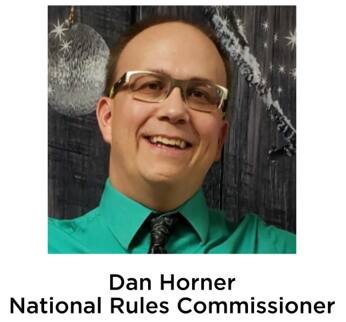
October 2022 Rules Rule
by Dan Horner, National Rules Commissioner

Q1. We are receiving. My partner put up his racquet (doesn’t swing) as I call “long.” It then hit my partner’s racquet. The ball was definitely going to hit the back wall based on velocity and height was shoulder height to my partner that was about 38 feet. Is that second serve or a point for the serving team?
A1. Thank you for taking the time to learn the rules of the game. What you have described would be a point for the serving team. A serve isn't long until it actually hits the back wall. One of the reasons is that in many circumstances it would be a very close call if someone were to catch the ball near the back wall. It sounds like in your situation it was definitely on the route to being long. However, there are some receivers that purposely return a soon-to-be long serve just to catch the server off guard and many times it works if they pass the ball well.
Q2. My partner insists on not putting on their goggles until the match starts. If the referee tells him that he must wear them, then he simply stops warming up and steps off the court until the match is ready to begin. What should the referees do in this situation?
A2. This is a good question. The answer is dependent on if it is an amateur match or a professional match. In the IRT, players are not required to wear protective eye wear during warm-up time. In the LPRT and in amateur play, eye guards are required even during warm-up time. Rule 2.5(d) states, “Proper protective eye wear [see 2.5(a)] and wrist cords must be used as designed during any on-court warm-up period. The referee should give a technical warning to any person who fails to comply during warm-up and assess a technical foul (without additional warning) if that player continues to not comply after receiving a warning about non-compliance during warm-up.” If I were the referee and I knew that this player always did this to push the envelope, I would warn them before they ever stepped foot on the court to begin warming up. Then I would give them a technical foul right off the bat when they began to practice on the court [see 3.17 and 3.17(c)].
Q3. Is it really necessary to always say “second serve” as a referee? The players all know that after I call a serve short on first serve that it is second serve, so why do I have to waste my breath?
A3. Yes, it is necessary to always say “second serve” prior to the server beginning the service motion after the first serve resulted in a fault serve. Rule 3.4 states, “The service motion shall not begin until the referee has called the score or “second serve” and the server has visually checked the receiver’s readiness.” Until the referee calls the score or second serve, the server isn’t allowed to serve the ball. Note that this is the moment when the 10-second time limit begins that the server is limited to, prior to serving [see Rule 3.5].
National Rules Commissioner Dan Horner welcomes questions from members and will respond timely along with occasionally featuring a few each month in USAR’s Serving Up the News. Write to Dan at rulescommissioner@usaracquetball.com, and you may see your questions in a future issue of this newsletter!